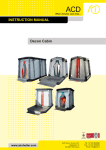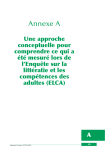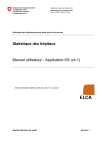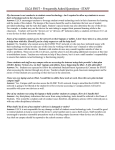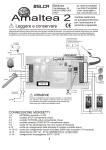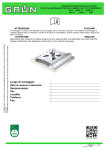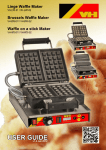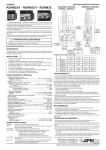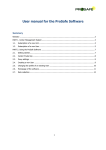Download 1. USER MANUAL.
Transcript
ING_Man_MITO-A-MINI_00.doc Radio Remote Control System MITO-A-MINI 1. USER MANUAL. Read this manual before using the radio control. To make the manual easier to consult, each section title is accompanied by a sign as a guide to the importance of the information given in the section. SIGN MEANING IMPORTANT! How to use the Radio control properly: Radio control user instructions. About the Radio control: Radio control technical data. Really know how to use the Radio control: Radio control details. IMPORTANT ANNEXES! Legal paperwork when using the radio control: instruction on compliance with statutory regulations. What’s more any parts requiring special care are in bold print. This manual can be changed without notice and is solely a guideline provided by Elca. This edition has been updated with the help of feedback received from our customers, so it can be considered a very valid aid for their work. This manual and any annex are property of ELCA with all rights reserved. Reproduction or transmission of any part of this documentation is prohibited in any form or for any reason without prior authorisation from ELCA. The ELCA logo is a registered trademark. - Page 1 - ING_Man_MITO-A-MINI_00.doc Radio Remote Control System MITO-A-MINI 2. USER INSTRUCTIONS 2.1 GENERAL OVERVIEW The ELCA MITO type radio control system is an innovative family of low power industrial radio controls, designed for controlling appliances that do not require a safety category 1 Stop command. The ELCA MITO type radio control system is made up of two main parts. The transmitter unit (AT) that permits the operator convey to the receiver the sequence of digital data that makes up a given command. The receiver unit (AR) that decodes the sequence of digital data and converts it into the electrical impulses required by the machine to actuate the command. The use of electromagnetic waves means that the control system leaves the operator free to move around the machine: in fact the transmitter unit does not require connecting cables, so the operator can stand away from the machine, in perfect safety and in an optimum position for controlling the machine movements. Each radio control uses a specific transmission telegram univocally programmed by the manufacturer and is not modifiable, so each transmitter unit will only operate with its associated receiver unit and therefore will not interfere with other radio controls. The working frequency is automatically selected when the transmitter is activated according to availability and lack of disturbance and persistent radio disturbance will automatically trigger a frequency change without interrupting operations. - Page 2 - ING_Man_MITO-A-MINI_00.doc Radio Remote Control System MITO-A-MINI 2.2 THE KEYPAD CONTROLS CHECK CHECK T9 T4 T9 T4 T10 T3 T10 T3 T11 T2 T11 T2 STOP T12 T1 START The left-hand diagram illustrates the keypad for the 6-function plus start & stop version. Transmission begins when the Start key is pressed, after entering the Pin code if this has been programmed, and ends when the Stop key is pressed or by auto-shutdown when no transmitter key is pressed for a set time (default 3 minutes). The right-hand diagram illustrates the keypad for the 8-function version. With this version transmission begins when any key is pressed and ends if no key is pressed after approx. 10 seconds. 2.3 A CORRECT AND SAFE USE OF THE RADIO CONTROL SYSTEM. IMPORTANT! The radio control operator must: - Be very well acquainted with the functions and characteristics of both the Radio control and the machine connected to the receiver unit. - Watch all the machine movements actuated by the radio control. - Shutdown the transmitter unit whenever work is suspended, even for a brief period. Do not rely on the auto-shutdown function. - Never leave the transmitter unit unattended. - Remember that the transmitter unit can actuate the machine movements even if it is situated in an enclosed place and a long way away from the receiver unit. Its improper use can cause severe damage and injury. - Never wash the units with a water spray, only use a damp cloth. - Do not use it inside shielded locations (e.g. inside the drum of a concrete mixer). Some of the more common functions: Activation: On continuous transmission versions having Start and Stop keys, press the Start key and the transmitter’s Check light on the transmitter will begin flashing. If a Pin code has been programmed this must first be entered before the Start key is enabled. On temporary transmission versions, without Start and Stop keys, press any key to activate the transmitter and the Check light will begin flashing. CAUTION!: The transmitter will only activate if the batteries have sufficient charge and if the receiver unit is powered and operational. Commands: Press the control keys related to the actions that the machine has to perform. Shutdown: On continuous transmission versions press the Stop button and the transmitter’s Check light will go out after about 2 seconds. On temporary transmission versions the transmitter will automatically shutdown about 10 seconds after the last key has been released. Auto-shutdown: Automatic shutdown of the transmitter when it is not being used. If this function is enabled the transmitter will shutdown if no key is pressed for a set period of time. The default setting is 3 minutes. Passive safety function: If there is an interruption in the radio link or radio interference is affecting all available frequencies, the receiver unit will automatically shutdown. - Page 3 - ING_Man_MITO-A-MINI_00.doc Radio Remote Control System MITO-A-MINI Battery charge indicator: When the battery is normally charged the Check light will flash rapidly (1 flash/sec). When the battery charge is not sufficient to ensure a proper transmission of the commands, the Check light will begin to flash slowly (about 1 flash every 2 seconds) for about 10 minutes before the transmitter finally shuts down. When the low battery charge signal appears it is good practice to place the machine in a safe mode, shutdown the transmitter unit and place it on the battery charger to charge it. 2.4 PROGRAMMABLE FUNCTIONS. CHECK CHECK T9 T4 T9 T4 The keypad has the following programming options: T10 T3 T10 T3 T11 T2 T11 T2 - Change frequency group - Auto-shutdown time - Pin code - Lock key programming T12 T1 T12 T1 Key attributions • Accessing the programming mode (Main Menu) CHECK T12 T1 CAUTION: It is good practice to always program the functions with the machinery shutdown or with the receiver power shut-off to avoid accidental machine commands. Shutdown the transmitter and then press T1 + T12 at the same time. At this stage the status LED will flash at 1Hz (on-off for equal times) and after 5 seconds the status LED will light up continuously. This indicates that the main menu of the programming mode has been entered and the transmitter will no longer send commands. • • • • • If a key is not pressed for 10 seconds the transmitter will quit the programming mode and shutdown. The main menu can be exited at any moment by pressing key T1. The transmitter will quit the programming mode and shutdown. When any of the programming submenus is entered, the LED will give two rapid flashes in one second. If a key is not pressed for 10 seconds the LED will stay on (i.e. main menu). After making a selection in any of the submenus, the status LED will give 3 flashes at 1Hz and then return to the main menu. When in a submenu and no selection is required, to return to the main menu wait for the 10-second time-out, this cannot be done manually. - Page 4 - ING_Man_MITO-A-MINI_00.doc • Radio Remote Control System MITO-A-MINI Change frequency group CHECK T2 When in the main menu press T2 to enter the “Change Freq. “ submenu 8 different groups can be set, each with 3 frequencies, by pressing the keys given in the table below: Group 1 def.( 434.100 – 434.325 – 434.600 MHz) Group 2 (434.150 – 434.375 – 434.650 MHz) Group 3 (434.225 – 434.450 – 434.700 MHz) Group 4 (434.275 – 434.500 – 434.750 MHz) Group 5 (434.125 – 434.350 – 434.625 MHz) Group 6 (434.175 – 434.400 – 434.675 MHz) Group 7 (434.250 – 434.475 – 434.725 MHz) Group 8 (434.300 – 434.525 – 434.775 MHz) • Key T3 X Key T4 X Key T9 X X X Key T10 Key T11 X X X X X X X X X X X Auto-shutdown time CHECK When in the main menu press T3 to enter the Shutdown Time submenu. T3 4 different times can be set by pressing the keys in the table below: 10 sec. ( set temp. tx mode ) (See Note) 3 min. – default ( only for cont. tx mode ) 10 min. (only for cont. tx mode) Off ( only for cont. tx mode) Key T4 X Key T9 Key T10 Key T11 X X X NOTE: This setting changes the system configuration from Continuous Transmission (i.e. Start key to activate radio link and Stop key to end) to Temporary Transmission where keys T1 and T12 are normal function keys and transmission is activated by pressing any key, only ending after the 10 second time-out. IMPORTANT: Remember to set the micro-switches on the base card with dip1=0n and dip2= 0ff for a correct operation of the T1 and T12 relays. - Page 5 - ING_Man_MITO-A-MINI_00.doc • Radio Remote Control System MITO-A-MINI Pin Code When in the main menu press T4 to enter Pin Code submenu. CHECK T4 Now set a sequence of 3 different keys. After the third key is pressed the setting is saved and the main menu is automatically restored. To eliminate the setting press T4 and then T1. Note 1: This function can only be used for continuous transmission (No 10-second auto-shutdown). Note 2: The default setting is with no Pin code. Note 3: If the pin code is forgotten a new keypad has to be programmed or the lock keypad function has to be cancelled to be able to use the transmitter. • Command lock programming: T9 CHECK This will activate or interrupt the transmission of a channel by just pressing a key once. The command is stopped by pressing the same key a second time. When in the main menu press T9 to enter the Lock Command submenu Now press any key to activate or, if activated, to release the Lock command function except the Start and Stop keys, which cannot be programmed with this function. When each key is pressed the setting is saved and automatically returns to the main menu. Note 4: This function can only be used for continuous transmission (i.e. No 10second auto-shutdown). Note 5: The default settings for standard radio controls do not include this programming function, it has to be selected by the user. - Page 6 - ING_Man_MITO-A-MINI_00.doc Radio Remote Control System MITO-A-MINI 2.5 ID CODE LEARN PROCEDURE. When a transmitter has to be associated with a receiver the transmitter ID code has to be memorised on the receiver. The ID code is a univocal identification attributed by the manufacturer to each transmitter so that unregistered transmitters cannot control the receiver mounted on the machine. When several transmitters are recorded on one receiver, the first transmitter to take control of the receiver has exclusive access over the others while the transmission link is maintained. The receiver can store a maximum of 20 codes. • Learn procedure: To access the learn procedure so the receiver can record the ID code of a transmitter: 1. Shut off the receiver power. 2. Open the receiver cover and make a note of the micro-switch settings on the receiver module. 3. Set micro-switch 4 on the receiver module to ON and 1,2 and 3 to OFF. 4. Power the receiver and the STATUS light on the base card will come on. 5. Activate the new transmitter. The STATUS light on the base will remain on, while the LEARN light will flash 5 times when the code learn procedure is complete. If there is an error (e.g. an st attempt to learn the 21 code) the LEARN light will flash rapidly. 6. Repeat the procedure from (5) for any other transmitters that have to be recorded. 7. Set micro-switch 4 to OFF (the base must be powered, otherwise it will not save the new data entered), the STATUS light will go out (if this does not happen the codes have not been learned and the whole procedure has to be repeated). 8. Shut off the receiver power. 9. Return the micro-switches to their original settings before the learn procedure. • Cancel procedure: To access the cancel procedure and erase all the ID codes recorded on the receiver: 1. Shut off the receiver power. 2. Open the receiver cover and make a note of the micro-switch settings on the receiver module. 3. Set micro-switch 4 on the receiver module to ON and 1,2 and 3 to OFF. 4. Power the receiver and the STATUS light on the base card will come on. 5. Set micro-switch 1 to ON. The LEARN light will come on. Now set micro-switch 1 to OFF. The LEARN light will flash 5 times and go out. 6. Set micro-switch 4 to OFF (the base must be powered, otherwise it will not save the new data entered), the STATUS light will go out (if this does not happen the codes have not been cancelled and the whole procedure has to be repeated). 7. Shut off the receiver power. 8. Return the micro-switches to their original settings before the cancel procedure. Now record new ID codes so that normal operation can be restored to the system. Note: If a transmitter is no longer used or replaced there is no need to cancel its ID code on the receiver unless the maximum number of codes has been reached. Nota1: If the receiver does not have an ID code recorded on it the STATUS light will remain on. - Page 7 - ING_Man_MITO-A-MINI_00.doc Radio Remote Control System MITO-A-MINI 2.6 CARE OF THE RADIO CONTROL SYSTEM During maintenance the receiver unit must not be powered and the transmitter unit must be shutdown. Even though the radio control system is practically maintenance free, some care and attention will ensure that the radio control system is kept in perfect working order. Periodical routine maintenance: - Transmitter Unit: Clean with a soft brush and damp cloth, do not use alcohol or solvents. Check the battery charger contacts are clean. Make sure the box is not damaged. Moreover, to ensure a long working life to the Radio control System, the following recommendations must be observed. - Transmitter Unit: Protect it from water sprays and heavy rain. Do not leave it in the sun. Do not wash it with water sprays or compressed air. Do not immerse the unit in water. 2.7 DISPOSAL When the radio control is broken or obsolete, it must be disposed of at a differential waste collection centre. Moreover old batteries must be disposed of in specific collection bins. 2.8 WARRANTY The Elca MITO type Radio Control System has a 24-month warranty with effect from the purchase date, as confirmed by the date of the Shipping Note, which must specify the serial number of the Radio Control System. Elca provides warranty cover on the Radio Control System for manufacturing defects in all its component parts, ascertained under the manufacturer’s indisputable opinion. The battery pack has a 12-month warranty from the purchase date. The user shall deliver and collect the unit to and from an Elca authorised aftersales service centres and the defective parts will be replaced free of charge. If a technician is requested on site the customer will be charged transfer expenses however the faulty parts will be replaced free of charge. The warranty shall be invalidated for tampering by unauthorised person not specifically authorised by Elca and in cases of improper use and installation. The warranty does not cover damage or loss during transport of the Radio control System. Elca shall not be held liable for damage to objects or injury to persons. Elca shall not be held responsible for machine downtimes since the user must have the facility to operate the machinery either manually or by cable. All controversies shall come under the jurisdiction of the courts of Bassano del Grappa (Vicenza - Italy). - Page 8 - ING_Man_MITO-A-MINI_00.doc Radio Remote Control System MITO-A-MINI 3. THE RECEIVER UNIT 3.1 RECEIVER LAYOUT BASE CARD LAYOUT / LAYOUT SCHEDA BASE DIP SWITCH AND LED CHECK POSITION ON RECEIVING MODULE /POSIZIONE DEI MICROINTERRUTTORI E SPIA CHECK SUL MODULO RICEVENTE - Page 9 - ING_Man_MITO-A-MINI_00.doc Radio Remote Control System MITO-A-MINI 3.2 RECEIVER WIRING EXAMPLES Vdc SUPPLY WIRING DIAGRAM / CABLAGGIO IN CONTINUA Vac SUPPLY WIRING DIAGRAM / CABLAGGIO IN ALTERNATA - Page 10 - ING_Man_MITO-A-MINI_00.doc Radio Remote Control System MITO-A-MINI 4. TECHNICAL DESCRIPTION. 4.1 GENERAL CHARACTERISTICS. Manufacturer................................................................................................................................................. ELCA S.r.l. Radio control type..................................................................................................................................................MITO Operating range...................................................................................................................................................... UHF ISM band working frequency ................................................................................................... 434.075 – 434.775 MHz Modulation type .................................................................................................................................................... GFSK Hamming distance ....................................................................................................................................................≥10 Working temperature .................................................................................................................................. -20 - +55 °C Storage and transport temperature ............................................................................................................ -20 - +55 °C Operating distance................................................................................................................................................150 m Passive safety stop time ......................................................................................................................................... < 2 s 4.2 AT MITO-MINI TRANSMITTER UNIT CHARACTERISTICS Model ...................................................................................................................................................AT MITO-A-MINI Radio transmitter/coding module...................................................................................................................SWE-A-00 Aerial.................................................................................................................................................................... built-in Power............................................................................................Built-in lithium polymer battery pack 3.7 V 1100 mA Absorption......................................................................................................................................................... < 25 mA Absorbed power................................................................................................................................................. < 0.1 W R.F. emission power .................................................................................................................................. < 3 mW ERP Flat battery warning voltage....................................................................................................................................3.4 V Flat battery shutdown voltage.................................................................................................................................3.0 V Charged battery autonomy at 20 °C ....................................................................................................approx. 50 hours Flat battery warning notice................................................................................................................. approx. 10 minute Protection rating.......................................................................................................................................................IP67 Dimensions ........................................................................................................................................... 113x60x26 mm Weight....................................................................................................................................................................100gr 4.3 AR MITO-MINI RECEIVER UNIT CHARACTERISTICS Model .................................................................................................................................................. AR MITO-A-MINI Radio transmitter/coding module...................................................................................................................SWE-A-00 Aerial................................................................................................................................. built-in or dedicated external Power................................................................................................................................................................ 9 -30 V≅ Consumption......................................................................................................................................................... < 5 W Relay outputs with NO contacts ........................................................................................................ max 8 commands Maximum voltage on contacts ...........................................................................................................................230 Vac Maximum current on outputs ..................................................................................... 10 A in AC1, 10 A in DC1 at 30V Protection rating...................................................................................................................................................... IP67 Dimensions ......................................................................................................................................... 165x107x50 mm Weight....................................................................................................................................................................450gr - Page 11 - ING_Man_MITO-A-MINI_00.doc Radio Remote Control System MITO-A-MINI 4.4 BATTERY CHARGER CHARACTERISTICS Supply voltage ....................................................................................................................................................5.0 Vdc Rated power ......................................................................................................................................................... < 3 W Rated output voltage............................................................................................................................................ 4.2 V= Rated output current .......................................................................................................................................... 450 mA Charging time ..................................................................................................................................................≤ 4 hours Working temperature .................................................................................................................................... -20 +55 °C Protection rating...................................................................................................................................................... IP40 Dimensions ............................................................................................................................................ 110x75x60 mm Weight....................................................................................................................................................................100gr AC Power unit: Power unit supply voltage..............................................................................................................80-250 Vac 50/60Hz Output voltage ................................................................................................................................................. 5.0 V 1 A Rated power ............................................................................................................................................................ 5 W DC Power unit for cigar lighter sockets: Power unit supply voltage.............................................................................................................................. 9 - 30 Vdc Output voltage ................................................................................................................................................. 5.0 V 1 A Rated power ............................................................................................................................................................ 5 W - Page 12 - ING_Man_MITO-A-MINI_00.doc Radio Remote Control System MITO-A-MINI 5. BATTERY CHARGER 5.1 USER INSTRUCTIONS Always charge Batteries without power interruptions and at ambient temperatures +5°C to +35° C. Firmly plug the power unit lead into the socket under the battery charger. Plug the power unit into its supply. The Power light will come on. Fit the transmitter on the battery charger pressing downwards until it clips into place. The battery should now begin charging. Check the indicator lights on the battery charger to make sure that the battery is being charged. The Power and Status lights will indicate the battery charging progress: POWER STATUS On Off Off On On On Charge condition Transmitter mounted on the battery charger: Battery charged to 100%. In high temperatures (>45°C) or low temperatures (< 0°C): charging has been interrupted to safeguard the battery because the temperature limit has been exceeded. Charging is restored when the temperature returns within the safety limits. Rapid charging in progress. The battery is charged rapidly to 70% capacity. (approx. time 2.5 hours) Slow charging in progress. The battery is charged slowly between 70 and 100% capacity (approx. time 2.5h). When the transmitter is mounted on the battery charge any radio link with the receiver is terminated. - Page 13 - ING_Man_MITO-A-MINI_00.doc Radio Remote Control System MITO-A-MINI 6. CONTENTS. 1. USER MANUAL. ............................................................................................................ 1 2. USER INSTRUCTIONS ................................................................................................. 2 2.1 2.2 2.3 2.4 2.5 2.6 2.7 2.8 GENERAL OVERVIEW............................................................................................................................................2 THE KEYPAD CONTROLS .....................................................................................................................................3 A CORRECT AND SAFE USE OF THE RADIO CONTROL SYSTEM. ...................................................................3 PROGRAMMABLE FUNCTIONS.............................................................................................................................4 ID CODE LEARN PROCEDURE. ............................................................................................................................7 CARE OF THE RADIO CONTROL SYSTEM...........................................................................................................8 DISPOSAL ...............................................................................................................................................................8 WARRANTY.............................................................................................................................................................8 3. THE RECEIVER UNIT ................................................................................................... 9 3.1 3.2 RECEIVER LAYOUT ...............................................................................................................................................9 RECEIVER WIRING EXAMPLES ..........................................................................................................................10 4. TECHNICAL DESCRIPTION........................................................................................ 11 4.1 4.2 4.3 4.4 GENERAL CHARACTERISTICS. ..........................................................................................................................11 AT MITO-MINI TRANSMITTER UNIT CHARACTERISTICS .................................................................................11 AR MITO-MINI RECEIVER UNIT CHARACTERISTICS ........................................................................................11 BATTERY CHARGER CHARACTERISTICS .........................................................................................................12 5. BATTERY CHARGER.................................................................................................. 13 5.1 USER INSTRUCTIONS .........................................................................................................................................13 6. CONTENTS. ................................................................................................................ 14 - Page 14 -














